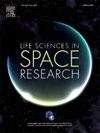Microgravity as a contributing factor to venous thromboembolism development: Risks and prevention strategies
IF 2.8
3区 生物学
Q2 ASTRONOMY & ASTROPHYSICS
引用次数: 0
Abstract
Venous Thromboembolism (VTE) being the third most occurring cardiovascular disease in the world after Myocardial Infarction and Stroke is very fatal. Being a multi-factorial disease, several risk factors in the terrestrial condition plays crucial part in the disease topography. Once exposed to microgravity, the weightlessness influences several thrombotic parameters, thus making astronauts in-flight to develop higher blood viscosity and increased risk of VTE. An astronaut travelling to the International Space Station developed a blood clot in the left internal Jugular vein, according to a recent case report. A proven way of treating clot development in microgravity does not exist. The information for the current investigation was gathered from reports that were readily available on microgravity and venous thrombosis. Reports on the impact of ground-based analogue and microgravity on the coagulation system demonstrate significant variation in study approaches, goals, and results. Based on the information that is currently available, it has been determined that little is known about the risk factors, pathological regulation, repercussions, and clinical manifestations related to coagulation systems in spaceflight (microgravity). Data, however, indicates that astronauts may be subjected to an elevated coagulation state in the cerebral venous systems when in spaceflight because of an increase in venous pressure and a decrease or reversal of blood flow. High fibrinogen levels, endothelial injury, and to some extent hypercoagulation were also noted. The study recognizes the critical need for additional research to assess the pathogenic processes in the blood that take place during actual spaceflight. This vital knowledge will advise risk estimation, diagnostic possibilities, and countermeasures for thrombosis mitigation in a microgravity setting during future space travel.

微重力作为静脉血栓栓塞发展的促进因素:风险和预防策略
静脉血栓栓塞(VTE)是继心肌梗死和中风之后世界上第三大心血管疾病,是非常致命的。作为一种多因素疾病,陆地条件下的几种危险因素在疾病地形中起着至关重要的作用。一旦暴露在微重力环境中,失重状态会影响几个血栓形成参数,从而使宇航员在飞行中产生更高的血液粘度,增加静脉血栓栓塞的风险。根据最近的一份病例报告,一名前往国际空间站的宇航员在左颈内静脉出现了血块。目前尚不存在治疗微重力下血栓形成的有效方法。目前调查的资料是从关于微重力和静脉血栓形成的现成报告中收集的。关于地面模拟和微重力对凝血系统影响的报告表明,研究方法、目标和结果存在显著差异。根据目前可获得的信息,人们对航天飞行(微重力)中凝血系统的危险因素、病理调节、影响和临床表现知之甚少。然而,数据表明,宇航员在太空飞行中可能会由于静脉压力增加和血流减少或逆转而导致脑静脉系统凝血状态升高。高纤维蛋白原水平,内皮损伤和一定程度的高凝也被注意到。这项研究认识到,迫切需要进行更多的研究,以评估实际太空飞行中血液中的致病过程。这一重要知识将为未来太空旅行期间在微重力环境下减少血栓形成的风险估计、诊断可能性和对策提供建议。
本文章由计算机程序翻译,如有差异,请以英文原文为准。
求助全文
约1分钟内获得全文
求助全文
来源期刊

Life Sciences in Space Research
Agricultural and Biological Sciences-Agricultural and Biological Sciences (miscellaneous)
CiteScore
5.30
自引率
8.00%
发文量
69
期刊介绍:
Life Sciences in Space Research publishes high quality original research and review articles in areas previously covered by the Life Sciences section of COSPAR''s other society journal Advances in Space Research.
Life Sciences in Space Research features an editorial team of top scientists in the space radiation field and guarantees a fast turnaround time from submission to editorial decision.
 求助内容:
求助内容: 应助结果提醒方式:
应助结果提醒方式:


